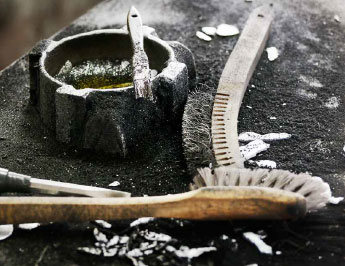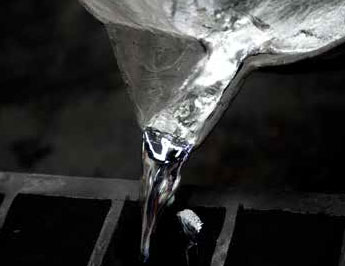Urania by Nils Gunnar Zander
For the fourth year, Byarums Bruk foundry has commissioned an artist to create a sculpture that will be cast in the foundry’s recycled aluminium in a numbered series. Nils Gunnar Zander was a natural choice. He has worked with a variety of materials and has a unique ability to breathe life into these materials. In 2015 he had a magnificent painting exhibition at Prince Eugen’s Waldemarsudde entitled “Tystnadens revir. 25 år från andra sidan” (“The Territory of Silence. 25 Years from the Other Side”), and in October 2006 he exhibited a beautiful and fascinating collection of primarily older works in clay and lead at Galleri L2 in Stockholm’s Old Town.
The name of the new sculpture is Urania. In Greek mythology, Urania was the daughter of the god Zeus and the Titaness Mnemosyne. She was the muse of astronomy and is associated with universal love and spirituality. She was also called “the heavenly one”. Urania has also been regarded as the mother of music. “That’s the highest art form,” comments Nils Gunnar, who listens to modern jazz, especially Miles Davis, while working. His Urania can be regarded as a torso, a thin bodily shell or a vest. The sculpture is reminiscent of a body floating in space. It creates an imaginary space around itself – a territory. This space gives the viewer room for thought and reflection, and also reminds us of our own silent inner space. Art is like that.

The name “Urania” was inspired by a book that his grandfather, Nils Björsell, received as a Christmas present in 1910, by French 19th century astronomer Camille Flammarion. Nils Gunnar found the book among his late mother’s belongings while working on an exhibition at Kristianstad Municipal Art Gallery in 2006. The book’s title was perfectly suited for the suite of paintings that he exhibited a year later in Australia, and he called the exhibition Urania 1.
The first chapter of the book is entitled “The Youth’s Dream”. Let me quote part of the introduction: “I was seventeen years old. Her name was Urania. Was she a young, fair, blue-eyed maiden, a youthful dream, an innocent but curious daughter of Eve? No, she was, quite simply, like the nine ancient goddesses of song, the muse of astronomy whose heavenly gaze ignites and guides the harmony of the spheres; she was the angelic idea that soars above earthly matter; she had neither flesh to restrain her, a heart that is heard beating from afar or the tepid warmth of human life. She existed in a kind of higher and eternally pure ideal world, yet she was human in name and form, and she awakened a deep and quickening feeling in my soul, an elusive, indefinable sense of admiration which can almost be described as love.”
Nils Gunnar Zander can look back over almost seventy years of life and fifty years as an artist. As a high school student, he was involved in the peace and anti- atomic weapons movements and spent endless hours hiding in the school art department painting and working with clay. He was dyslexic so had to learn the content of his school books by heart. This resulted in an enormous respect for letters and words with their condensed and expressive content.
He developed an early interest in Dag Hammarskjöld’s work. “Strangely enough, when Hammarskjöld died in the plane crash in Zambia in 1961, it brought him to life for me. I clearly remember the torchlight procession through Stockholm after his death. People had gathered from far and wide. We marched in solemn silence through Stockholm. What had happened would change history forever. It became more important than ever to promote peace and combat atomic weapons. I bought Hammarskjöld’s book Waymarks, published in 1962, for my mother. His haikus have accompanied me through my life ever since.” To mark the Dag Hammarskjöld celebratory year in 2005, Nils Gunnar created a suite of works using Hammarskjöld’s poetry.In 1964, at age 20, Nils Gunnar began studying at the ceramics department at the University College of Arts, Crafts and Design in Stockholm. Over the next few years there was a lot of turbulence at the college, like in other colleges and universities around the world. But while the other students discussed politics, he concentrated on ceramics. His views were already clear. Peace was the only possible answer. He graduated in 1968. He won a scholarship to study in Kilkenny, Ireland, a unique and fascinating art and craft centre that had many ties with Scandinavia. He learned to create turned plaster moulds for casting pottery. Some of his colleagues became lifelong friends, and he has returned there several times to hold exhibitions.
At the time, military service was obligatory in Sweden. As a pacifist, Nils Gunnar did service in a hospital and then enrolled a postgraduate course at the University College of Arts, Crafts and Design in Stockholm. He wasn’t interested in shiny glazes or perfectly turned shapes. What fascinated him was burnt, unglazed clay with a crumbling, cracked look and a sensuous, tactile feel.

Petra, the legendary gallery owner had an uncommon knack for discovering new talent. She painstakingly selected the tiny handful of young artists who were offered their first exhibitions at her gallery. Nils-Gunnar was one of them. His debut was in 1971. His large, expressive masks and small bud-shaped heads appealed to both critics and the public. His attitude to materials and expressive use of burned, cracked, rough sanded surfaces was something new.
The materials offered a link to a deeper awareness. But rather than materials, I would describe it as a fascination with matter, its consistency, the various expressive possibilities of the surface, decomposition, abrasion, fading symbols, the feeling of something about to disappear. When I look at his works, I see a coherent interweaving of themes that revolve around a common hub, regardless of the techniques used. Later in the 1970s, he moved on to other materials, paper and lead. Some of these works were exhibited in 1979 at the Doktor Glas gallery in Kungsträdgården. He stamped words and symbols into the soft, matte, silk-like surface of the lead. He made the paper himself to achieve the expressive consistency and matte sheen he needed. Creating or choosing the actual material is a key part of the process. His sculptures were like shells, whether they portrayed bodies, doors, unopened envelopes or parcels. “The content should be imagined by the viewer,” he comments. “As long as a letter is unopened, the mystery remains. The magic often disappears after the letter is read.”
He met author and poet Staffan Stolpe on a Greek island. They began working together. Nils Gunnar transferred stanzas from his poems to lead or paper panels. “Staffan’s poem line There is no secret had a shattering effect on me,” he says. “There’s nothing behind or inside.” They exhibited their joint works at Doktor Glas gallery in 1987. Nils Gunnar had stamped words on the grey lead panels with wooden stamps or lead types. The words sometimes stood out and sometimes merged in. They were fragments of something important that had once existed. “Clay requires you to work quickly. I could return to the lead panels again and again, working slowly and thoughtfully.”
“I also started working with Dag Hammarskjöld’s haikus. His lines “It will never return. A different man will find a different city” had a concrete impact on me. I had separated from my ex-wife. I changed direction as an artist. Even if you come back to an idea you’ve worked on in the past, the result is never the same. The same applies to everything really. You can never recreate or relive the same feeling.” Nils Gunnar went travelling and ended up in Melbourne, Australia. He completely abandoned clay and began painting.
He started collaborating with Byarums Bruk foundry two years ago. An earlier Urania sculpture exists, which Nils Gunnar cast in bronze thirty years earlier while visiting the glass artist Erik Höglund in a small town in southern Switzerland. Höglund, who became blind in later life, had been commissioned to produce a cast bronze sculpture, and asked Nils Gunnar to help him by checking the final result. Whilst there, Nils Gunnar made a cast of a small torso sculpture he had created, which resembled a vest. But aluminium has different characteristics to bronze and lead, and requires different working met- hods. He made the whole shape out of a single sheet of wax 2 cm thick in his studio on Brännkyrkagatan. The craftsmen at Byarums Bruk coated the wax with a green shimmering surface to separate the sculpture from the mould. Nils Gunnar’s work was pressed into the sand and then removed. The empty space was filled with recycled aluminium. The material – aluminium – has a clearer texture due to the sand, creating a coarser expression than the lead panels Nils Gunnar has worked with in his own studio. But he sees this as an advantage. It gives life to the surface.
Australia, where he lives for six months of the year, has influenced his subject matter and view of the world. In this remarkable continent, nature is ever hostile, regarding its inhabitants as intruders and waging a constant battle on them with its endless red sand deserts, frequent wildfires, poisonous snakes and vast distances. The Aboriginal Australians learned to respect their unwelcoming surroundings, as is exemplified by their songlines or dreaming tracks. Nils Gunnar is inspired by their art and outlook.
In his paintings, he returns time and time again to the remarkable Australian nature. He looks deeply inside the red earth, the rough, cracked ground, the vast landscapes, the burnished light and the dried-out salt lakes, trying to grasp their essence. The paintings are not smooth and glossy. Their surface texture invites the touch and beckons the viewer inside. Urania has the same inviting effect.
For more information, download our press kit.
Text: Kerstin Wickman, Professor Emeritus in Design and Craft History.

